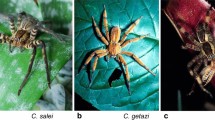Abstract
The reflex excitability of flexors and extensors of the upper and lower extremities during local thermostimulation of their receptor fields was investigated in observations on healthy subjects and patients with spastic hemiparesis by means of monosynaptic testing. In the healthy subjects, cooling led to a reduction in reflex excitability, while warming led to its elevation. On the contralateral side thermostimulation induced the reverse effect. A change in the directionality of the reactions was observed in ill subjects in the form of an increase in excitability in response to cooling. The data obtained show that the state of the thermoreceptive fields may influence the reflex excitability of motoneurons in a specific manner. The character of this influence in its turn probably depends on the initial state of the generator of locomotion.
Similar content being viewed by others
Literature cited
L. O. Badalyan and I. A. Skvortsov, Clinical Electromyography [in Russian], Meditsina, Moscow (1986).
K. V. Baev, Neuronal Mechanisms of the Programming of Rhythmic Movements by the Spinal Cord [in Russian], Naukova Dumka, Kiev (1984).
A. V. Cheremis, The Influence of Thermostimulation of Various Receptive Fields of the Lower Extremities on the Reflex Excitability of Motoneurons of the Human Spinal Cord, Abstract of Dissertation for the Degree of Candidate of Medical Sciences, Alma-Ata (1979).
G. Shepherd, Neurobiology, Vol. 2 [Russian translation], Mir, Moscow (1987).
B. L. Day, C. D. Marsden, J. A. Obeso, and J. C. Rotwell, "Reciprocal inhibition between the muscles of the human forearm," J. Physiol.,349, Mar., 519–534 (1984).
J. C. Eccles and A. Lundberg, "Synaptic actions in motoneurones by afferents which may evoke the flexion reflex," Arch. Ital. Biol.,97, No. 2, 199–205 (1959).
H. Hensel, "Correlation of neural activity and thermal sensation in man. Sensory function of the skin in primates," in: Prol. of International Symposium, Stockholm (1985), pp. 331–353.
C. C. Hunt, "The reflex activity of mammalian small-nerve fibers," J. Physiol.,115, No. 4, 456–469 (1951).
Additional information
Institute of Physiology, Kazakhstan Academy of Sciences, Alma-Ata. Translated from Neirofiziologiya, Vol. 24, No. 5, pp. 598–604, September–October, 1992.
Rights and permissions
About this article
Cite this article
Abuzyarova, M.B., Cheremis, A.V., Abeuova, G.K. et al. Generator of locomotor activity as a probabilistic modulator of the afferent stream from thermoreptors of the dermal fields of flexor and extensor muscles. Neurophysiology 24, 395–399 (1992). https://doi.org/10.1007/BF01052859
Issue Date:
DOI: https://doi.org/10.1007/BF01052859




